The Perverse Appeal of 6th Avenue
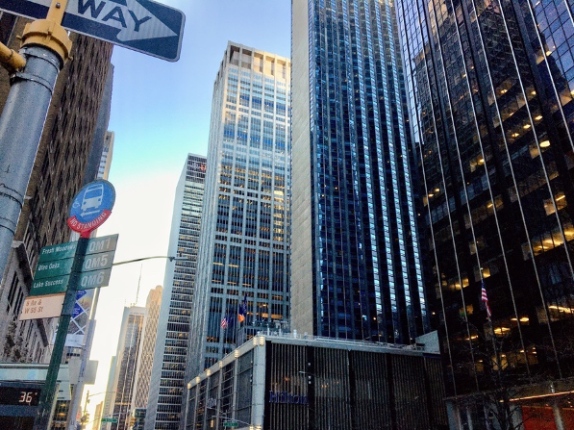
"More than any other street in New York, perhaps more than any other in a major city in the world, the midtown stretch of Sixth Avenue, especially in the twelve-block stretch north of 43rd Street, was the representative street of twentieth-century Modernist urbanism."
New York 1960, Stern, Mellins, Fishman
I didn’t just dislike that place when I was a teenager. I hated it.
It represented a lot of what I was rebelling against: corporate culture, conformity, capitalism: soullessness. It seemed dehumanizing and the people working there were reduced to cogs. The buildings were ant farms, or giant dominoes. The ones between 48th and 50th were so interchangable that even the developer called them the X, Y, and Z buildings. It’s been written that these kinds of buildings looked like the boxes that real buildings came in. One critic called them "the sinister Stonehenge of Economic Man".
I wasn’t alone.
"The corporate investors are determined to follow the same tried and true, catastrophic course of construction that has made New York a less and less viable place: the familiar, Neolithic pattern in which a specific number of square feet of self-contained total depersonalized office space replaces a variety of small, necessary local facilities and functions, with the corporate giants hermetically sealed off from their surroundings by a few more pointless, windswept plazas and a dull clutch of ground-floor banks."
Ada Louise Huxtable New York Times, May 1968
And ten years later, this comparison to Rockefeller Center just to the east:
"The contrast between the original development and the extension west of Sixth Avenue invite numerous comparisons: benign paternalism to the east, bureaucratic imperialism to the west; a unified family on one side, a row of caricatured corporate headquarters on the other; to the east a powerful yet humane architecture sensitive to light, to air, to scale, a product of romantic functionalism and creative opportunism, in contrast on the west to a one-dimensional good taste, gift wrapped architecture developed to contain the greatest amount of space permissible and through improved technology able to ignore all natural constraints. Each building is a general issue product of bureaucracies that differ only in name, unconstrained by history or nature."
"Rockefeller Center, Architecture as Theatre", Alan Balfour 1978
Yikes.
But it wasn’t so great before either, when there was an elevated subway overhead:
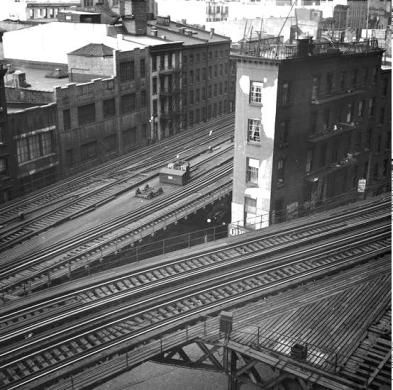
"Flanked by smartness and gayety, crossed and crisscrossed daily by millions of people in search of amusement and merchandise, it stood for thirty years dark, dirty, and vacant…it has been called the Cinderella of Gotham, the unlovely sister of the bright and thriving streets beside it."
NY Times, 1939
These big slabs of steel, concrete, and glass are masculine. They were designed for the men of Exxon, Union Carbide, Celanese, Time Magazine and McGraw Hill and not for the women who typed their memos and brought their coffee. It was hard not to notice.
Here, a review of the restaurant in the CBS Building:
"Since the building has a monolithic power, unequivocal masculine strength was called for, a total abjuration of the phony, a menu both hearty and international; uncompromised quality in food, service and décor, with commensurate prices; an open kitchen and stand-up bar; no aping of period décor, but traditional luxuries – fine mahogany, leather, velour, brass, crystal, silver, china; what looked expensive would be expensive."
Olga Gueft, Interiors Magazine
There was, though, a gay subtext. McGraw Hill was ready to pull out of crumbling New York and move to the suburbs. But according to Sheldon Fisher, the president of the company, "it was the requirements of the company’s creative people that tipped the balance in the city’s favor: ‘Whatever their needs or inclinations, they can better satisfy them in New York than anywhere else.’"
But as cold and corporate as it was, it also sprouted uniquely American weirdness.
Like the Black Israelites who would man a table in one of the plazas, dressed all in white with turbans, proclaiming that Jews are imposters and they are the real descendants of the 12 Tribes.
Or Marilyn Monroe inaugurating the Sidewalk Superintendents Club at the groundbreaking of the Time Life Building.
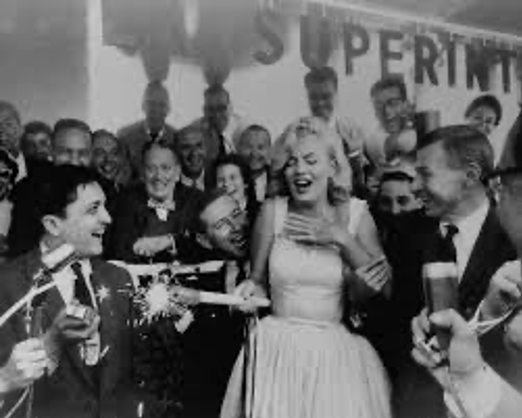
Here’s a great video.
I was always fascinated by Moondog, "The Viking of 6th Avenue".

He’d stand there all day like a statue, blind, selling his poetry, as if he had time-travelled from 10th Century Norway. Or even just space travelled, from a couple of miles south in Greenwich Village where he would have made more sense.
He was friends with Charlie Parker, recorded an album with Julie Andrews, and was roommates with Philip Glass. A great composer, he later became a classical music star in Germany.
Andy Warhol designed an album cover for him, with lettering by Warhol’s mother:
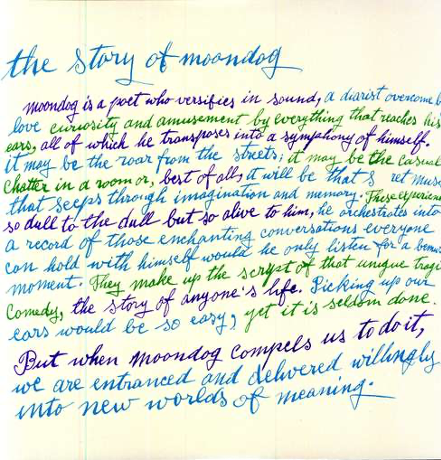
Check out my favorite of his pieces, Bird’s Lament.
Surrounding this stretch of cubicles, there’s the raucous fun of the Big Apple.
To the east, Radio City and the Art Deco exuberance of Rockefeller Center.
To the south, Times Square and the Broadway shows.
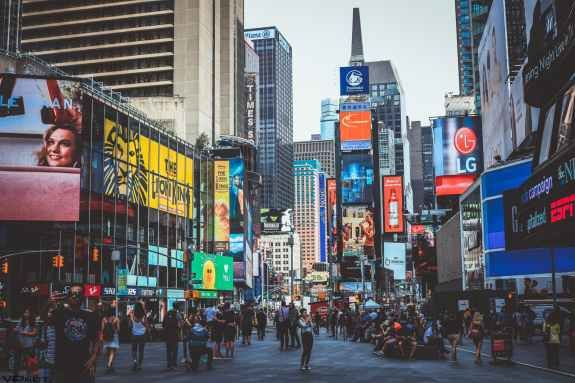
Photo by Vlad Alexandru Popa on Pexels.com
There used to be, in Chelsea on 6th Avenue, the houseplant district, a little hit of sidewalk tropics in the city.
And there was a strip of weekend parking lot flea markets where Warhol would add to his hoard.
Farther south on 6th, the Women’s House of Detention, right in the heart of Greenwich Village, where prisoners could shout conversations with bystanders.
But this piece is about the stretch of 6th Avenue in midtown.
The funny thing is that I’ve changed my mind. I hated it but now I love that strip. Maybe it’s because I loved Mad Men or maybe it’s because the post-modern buildings that came later are so much worse. It’s full of people, there are lots of places to eat. It’s actually kind of sexy, but maybe that’s just because of the sheer number of people.
Or maybe it’s just a great place, like a steel and glass Grand Canyon. And there’s no other place like it on Earth.
Saul Steinberg: Dottore in ArchitetturaNovember 11, 2010In "architecture"
The ClientSeptember 10, 2013In "architect"
OFF THE GRIDFebruary 27, 2014In "cities"
6th Avenue, Buildings, cities, David Prowler, midtown manhattan, modernism, Rockefeller Center, Urbanism
February 15, 2020
2 comments
Comments RSS and TrackBack URI
-

-
 Stefan Denig
Stefan DenigHi David,
Great post, thought all the time while reading it: yes, he‘s right but why have I always loved this part of mid-town so much? Probably because I only saw it first in the early 1990ies and it felt so overwhelmingly like Manhattan. Nice surprise to read the unexpected love twist at the end!
Greetings from in the middle of nowhere in India‘s Rajasthan. 6th Ave feels far away here.
See you this year in Europa?
Would be great. It‘s about time!
Big hug to Simone too
Stefan
Holen Sie sich Outlook für iOS ________________________________ Von: David Prowler Blog Gesendet: Saturday, February 15, 2020 9:52:36 PM An: [email protected] Betreff: [New post] The Perverse Appeal of 6th Avenue
David Prowler posted: " "More than any other street in New York, perhaps more than any other in a major city in the world, the midtown stretch of Sixth Avenue, especially in the twelve-block stretch north of 43rd Street, was the representative street of twentie"
February 16, 2020 7:12 pm
Leave a Reply
Email Subscription
Enter your email address to subscribe to this blog and receive notifications of new posts by email.
Email Address:
Join 72 other subscribers-
Recent posts
